
Do Dive into Web3 Games: Token Economy and Content Design
Focusing on the STEPN case

1. Introduction
1.1. Problem I: Token economy
When discussing the sustainability of the current Web3 gaming, the most important aspect is the token economy. This is because most Web3 game projects use their own tokens in the form of in-game currency, so the user (or gamer) experience varies greatly depending on the token value.
In most Web2 games, when purchasing in-game currency, it is impossible to withdraw money, or there are restrictions for withdrawals. Unlike existing in-game currency, which are circulated in a closed economic system or an environment where cashing out is not easy, tokens are inevitably more unstable because they are closely connected to the real market, resulting in a high chance that the token value will fluctuate according to the demand and supply in the real market.
1.1.1. Problem of openness
The openness of the in-game currency can be pointed out as an element impeding the stabilization of the Web3 game ecosystem, and it could appear that the problem can be solved by preventing the outflows in the in-game economy. However, since many Web2 games already implement an in-game economy and one-way interaction (inflow O/ outflow X) system of users, the biggest difference that current Web3 games gain by introducing blockchain-based assets (FT & NFT) can be said to be two-way interaction (inflow O/ outflow O) between the in-game economy and users.

Therefore, when discussing the Web3 game economy or dealing with blockchain game assets, the openness of the in-game economy is an essential element, and ways to maintain the characteristics of the open economy while also achieving the stabilization of the ecosystem should be discussed.
1.2. Problem II: Content design
Meanwhile, the poor content quality of Web3 games has also been highlighted as a problem. Many users of the Web3 game participate in the game with the aim of profit-making on the P2E (play-to-earn) system, and the reality is that the Web3 game does lack many elements enabling users to feel “fun” besides earning money. After covering the token economy, I will briefly introduce the theory of gaming content design and describe it in a way that applies to comparable cases.
1.3. Case study & takeaways
This article will unfold this discussion by taking an in-depth analysis of STEPN, famous for its move-to-earn (M2E) project. There are two reasons for selecting STEPN as an analysis target. First, it is the best example of the instability of the P2E system due to the sharp fluctuations of in-game currency. Second, it is well-considered as a reference case in terms of Web3 game tokenomics by showing ongoing efforts to improve tokenomics even after the sharp drop in in-game currency.
2. Background
2.1. STEPN system overview
STEPN gives GST, the basic in-game currency, as a reward in proportion to the amount of time to walk or run after purchasing Sneakers NFTs. The higher the number of NFTs you have and the higher the attributes of the Sneakers you use, the more in-game assets you can obtain, including GST. The STEPN ecosystem comprises various economic systems using in-game assets, but the core systems for discussion can be summarized as follows.
2.1.1. Energy System
The higher the number of Sneakers NFTs owned and the level of NFT used, the higher the energy given to STEPN users daily, with 5 minutes of GST farming time given per 1 energy unit per day. The amount of energy given according to the number of NFTs possessed is shown in the table below.

2.1.2. Sneaker attributes
Each Sneakers NFT has four unique attributes and varies according to level, NFT type, and quality. Each ability index has the following properties.
- Efficiency: The higher the Efficiency index, the more GST earned per 1 energy unit.
- Luck: The Luck index is related to the mystery box drop rate. The higher the number, the higher the probability that a higher-level mystery box will be dropped when more than a certain amount of energy is expended.
- Comfort: The higher the Comfort index, the lower the Sneakers NFT’s HP reduction rate and the more GMT mined per day.
- Resilience: The higher the Resilience index, the lower the durability reduction rate of Sneakers NFTs.
2.1.3. Mystery box and gem
A mystery box is an item that can be obtained when more than a certain amount of energy is consumed as a Sneakers NFT with a Luck characteristic, and a mystery box can be opened to obtain a gem NFT by consuming more than a certain amount of GST.
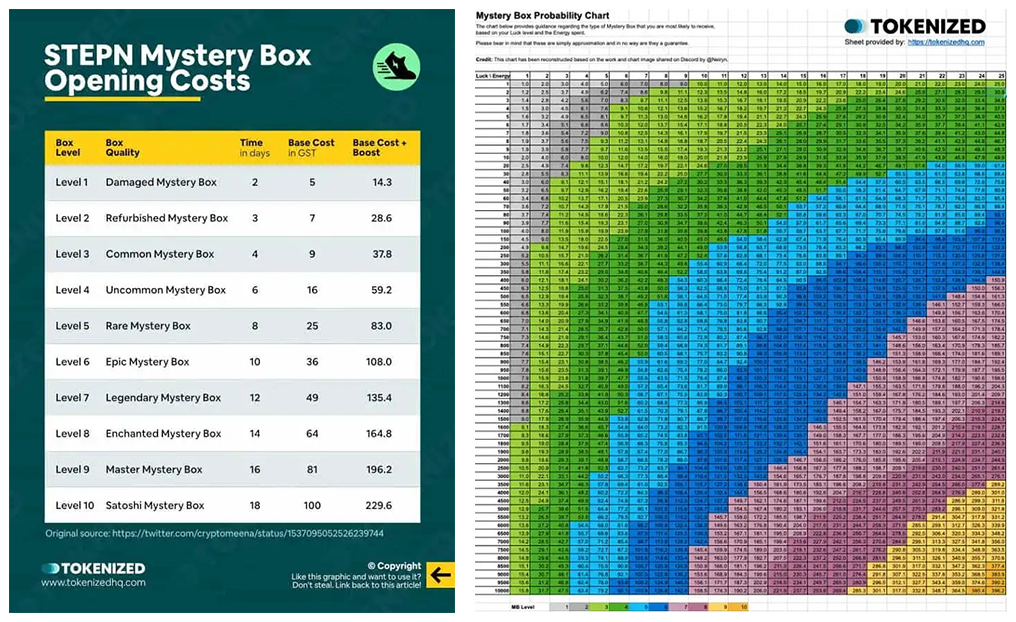
There are four types of gems NFTs corresponding to the respective ability indices of the Sneakers NFTs, and when equipped, the corresponding indices are increased. Each Sneakers NFT has four sockets that can be equipped with gems, and the types of gems that can be loaded into each socket are arbitrarily determined.
- Yellow: Efficiency
- Blue: Luck
- Red: Comfort
- Purple: Resilience
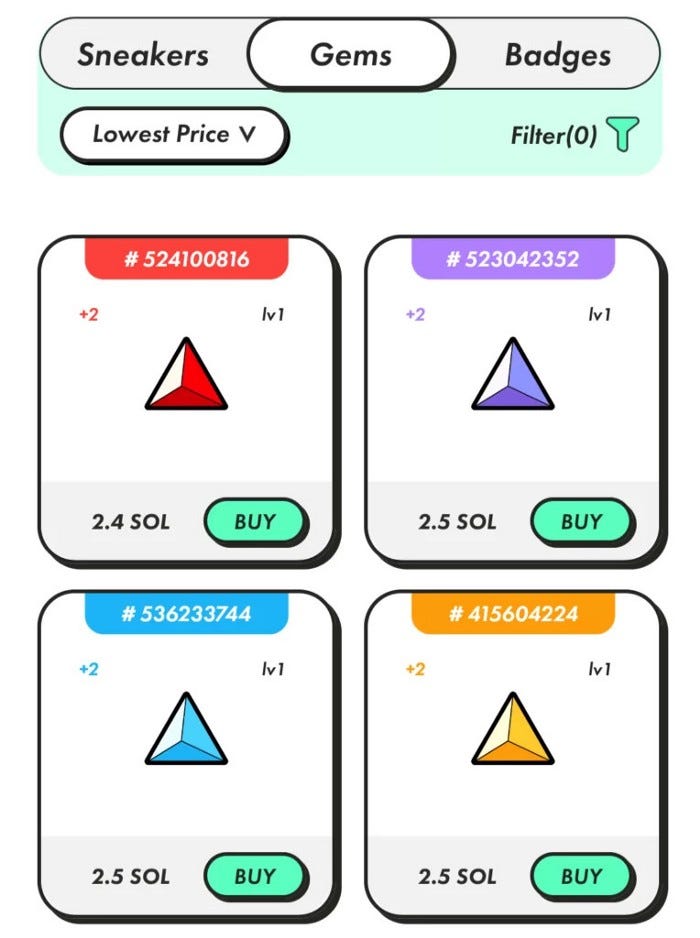
2.2. Game economy design
Boffin, a contributor to the crypto news channel ‘Page One’ and interested in behavioral economics, describes elements to consider when designing a game economy in his article ‘Designing Better Game Economies’. Game economy design refers explicitly to the generation and circulation of game resources, such as game money and experience. According to Boffin, game economy design consists of five major axes of faucet, inventory, converter, sink, and trader respectively.
- Faucet: The emergence of new resources in the in-game economy
- Inventory: Methods of stockpiling or owning game items
- Converter: A specific resource is converted to a resource of a different characteristic, that is, sinking a particular resource through the faucet of another resource.
- Sink: The exact opposite of faucet, removing resources from the in-game economy.
- Trader: Resources are traded among users or between users and NPCs
During the following discussion, I will cite Boffin’s five elements.
3. Part I: Game Token Economy
3.1. STEPN token economic analysis
Launched in December last year, STEPN showed rapid growth until May of this year based on the number of users and token price. The price of GST, which can be obtained just by walking or running, which is the essential in-game play, has continuously increased. Therefore, the main actions of users are focused on GST farming, which is done daily and selling GSTs to the market by adjusting the optimal NFT setting.

Due to this trend, the STEPN ecosystem concentrates the demand for assets related to GST farming, and the assets closely related to GST price in the ecosystem include the following.
- Sneakers NFTs: The more the number of Sneakers, the more energy is required to mine GSTs
- Scroll Item: Items required for minting Sneakers NFTs
- Efficiency Gem: Increases the Efficiency ability that increases GST Mining
The bias in demand for the above assets was clearly revealed in the price trend of gem items, where there are different types of NFTs for each index characteristic. According to the gem price trend chart provided by STEPN Chartz, even in early June, when the GST price fell sharply, the Efficiency gem price remained significantly higher than other gems.
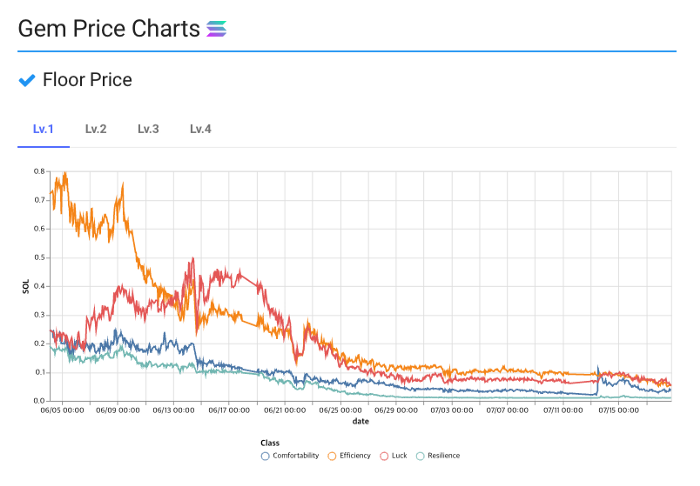
3.1.1. GST token flow and MUDflation
Early stage of the game, the GST price increased due to the user’s GST farming amount, due to the supply being limited with demand for the Sneakers NFT setup being large. However, while the demand for NFT setup decreases over time, as the number of users who can stably farm GSTs increases, the GST supply will overtake the demand. As a result, the price of in-game GST currency falls as the supply to the market continues to increase.
This is a common situation in games, especially in the MMORPG genre, and is called MUDflation, which is a portmanteau of MUD (multi-user dungeon/ dimension) and inflation. When a virtual currency is continuously generated inside the game and is accumulated in the virtual economy inside the game without disappearing, its value will continuously drop in the market, referring to the occurrence of extreme internal inflation. (Excerpt from ‘Kim Hyeong-Jung, Virtual Economy in Online Games: Current Status and Prospects, 2010’).
Along with the decline in token value, the open economy characteristics of the Web3 game ecosystem caused many users to sell their game assets, such as NFTs, when it became difficult to generate additional revenue, which led to a plunge in NFT prices, including GSTs. With Boffin’s 5 elements of game economy design mentioned earlier, the token flow of STEPN’s rise and drop will be described as follows.

- Trader -> Inventory: For NFT setup, users purchase GST and enter in-app environment
- Inventory -> Sink: GST used for in-app activities is burned
- Sink -> Faucet: Most of the in-app activities done through burning GSTs lead to increased user play rewards
- Faucet -> Inventory: Users receive daily GST rewards through gameplay
- Inventory -> Trader: the GSTs received are sold as a reward to the market
Growth period: GST demand for NFT setup overwhelms GST supply, causing the token price to rise.
Decline period: The demand for NFT setup decreases, with an increasing number of users who continue to sell GST rewards to the market, causing the token price to decline.

3.1.2. Analysis and assessment
The price of GST used as an in-game currency is a factor that greatly affects the gamer experience. Too high of a GST price makes it difficult to enter the game because the setup cost for gameplay is too high, while a too low of a GST price may not provide adequate motivation to users.

The cause of the fluctuation of the GST price can be seen as a problem with the GST token flow in the STEPN ecosystem. The supply of in-game currency is basically regulated through the balance between faucet and sink, but in the mechanism of selling GSTs for profit-making, GSTs are not burned but accumulated in the market (trader). In fact, as shown in the graph above, the GST circulation increased rapidly, and the increase in circulation led to a decrease in the GST price.
3.2. Aspects of token economy improvement efforts
The GST price plummeted from May due to the rapid increase in circulation and the overall market stagnation, settling at a price of around USD 0.1 since July. The project side acknowledged that there was a problem in the design and operation of the project in June and published an article on issue analysis and assessment through its own medium (link). Among the four problems that were pointed out, the 4th item was the most notable.
Problem 4
The lack of self-adjusting mechanisms of the sneakers and gems, and the inflation of these assets.
STEPN analyzed that the deflation mechanism was lacking for all in-game assets, including GSTs. This problem was not highlighted in a situation where demand for in-app assets is overflowing (boom), but the moment when further demand is no longer generated as circulation accumulates will cause asset prices to plummet, disrupting normal economic cycles and hampering user experience.
3.2.1. Updates and emergence of new strategies
In July, STEPN performed a large-scale update, and the main contents related to token flow improvement are as follows.
- The rollout of the HP system
- In the context of being similar to durability but close to the lifespan of the Sneakers NFTs, HP is reduced as much as energy is consumed. At an HP below 20%, energy can no longer be gained, and at an HP of 0%, play is terminated.
- You must expend Comfort gems, GMT, and GST to recover your HP.
- HP must be restored to 100% to list NFTs on the Marketplace - Mystery box system improvements
- Mystery boxes from levels 1 to 10 appear.
- The higher the level of the mystery box, the better the reward, while the number of GSTs required to open the mystery box also increases.
- To obtain the mystery box, certain play conditions must be met, such as needing to exceed a certain amount of energy spent at once.
1/10
— STEPN | Public Beta Phase V (@Stepnofficial) July 13, 2022
Update time!
In our efforts to implement an additional token sink and bring relevance to the Comfort attribute prior to GMT earning being released, we are introducing a new attribute:
Health Points (HP) 💖
The above update and the drop in GST price caused a change in the mystery box farming strategy of STEPN users. This is because the strategy of simply mining and selling GST did not bring effective profits to users, while mystery box farming showed profitability. Below is an example of how to perform the mystery box strategy and expected profit.
3.2.2. Mystery box mining strategy example
Strategy overview
- Mining level 5 mystery box
- NFT setup based on asset price on Oct. 6th (Source: stepnfp.com)
- 15-pair Uncommon Walker Sneakers setup
- Non-stop walking for 65 minutes every day
Asset price as of Oct. 6
- Common SNKRZ FP (floor price): 1.17 SOL
- Uncommon SNKRZ for setup price: 5.5 SOL
- Efficiency Lv.2 Gem FP: 0.11 SOL
- Luck Lv.2 Gem FP: 0.284 SOL
- Sneakers level-up cost (lv.1 -> Lv.24): 365 GST + 100 GMT
- SOL price: about USD 34
- GST price: about USD 0.024
- GMT price: about USD 0.62
Total setup cost
- Buy 14 pairs of Common SNKRZ: 1.17 * 14 = 16.38 SOL
- Buy 1 pair of Uncommon SNKRZ: 5.5 SOL
- Buy 1 Efficiency, Luck Lv.2 gem each: 0.11 + 0.284 = 0.394 SOL
- Level-up cost: USD 8.76 (GST) + USD 62 (GMT) = USD 70.76
- Total: about USD 828

According to the information provided by Krit_STEPNstats (refer to the above chart), the expected return and funds payback period based on the asset price as of October 6 are as follows.
Expected return and payback period
- Estimated GST Farming Revenue per Month: about 100 GST per day * 30 = 3,000 GST = USD 72
- Estimated monthly mystery box farming revenue: USD 151
- Total monthly estimated revenue: USD 223
- Estimated payback period: about 3.7 months (or 111 days)
3.2.3. Significance of strategy change
The significance of the change in users’ main strategy from simple GST farming to mystery box farming is as follows.
- Diversification of demand for in-game assets

The impact of the change in strategy has dispersed demand, which has been concentrated on GST-related assets, to various assets. In the previous gem item price trend, until June the Efficiency price, an asset related to the increase in GST farming amount, far exceeded the price of other gem items. Conversely, the trend shows diversified demand for gem items after July and gem price rankings being reorganized due to the GST price plunge (reduced demand for Efficiency gems), shift in the mystery box strategy (increased demand for Luck gems), and expectations of the HP system and GMT farming (increased demand for Comfort gems).
2. Virtuous cycle of the economy in the game
The shift in game strategy reduces the overall GST supply of the game economy by making an investment in the Luck ability index related to the mystery box instead of Efficiency, which is the ability index involved in GST generation, while also requiring GSTs to open the mystery box, which leads to burning a greater amount of GSTs. Conversely, since the gem item rewards given to users are traded in SOL in the market, they also serve to minimize external pressure on the price of in-game GST currency rather than when users adopt the GST selling strategy. This can be justified by the fact that a large amount of leveraged trading for GSTs occurred during the GST decline.

3. Earning revenue through NFT trading
Damage to the user experience can be minimized by incentivizing users to not sell in-game GST currency for the purpose of profit-earning with rewards gained through NFT trades, thus stabilizing the price of in-game currency. Moreover, using the mainnet coin, which has a relatively large market capitalization, as the displayed currency, transactional inefficiency due to fluctuations in the displayed currency price is minimized.
3.2.4. GMT mining update
STEPN conducted a GMT mining update in October, and the main contents are as follows (link).
GMT farming method
- STEPN users can farm GMT instead of GST if certain conditions are met.
- Generation 0: GMT farming is possible when normal Sneakers reach NFT level 30; the higher the Comfort index, the higher the GMT farming amount.
- Generation 1–3: GMTs can be farmed through NFT Rainbow Sneakers.
Rainbow Sneakers
- Rainbow Sneakers NFTs can be obtained through ‘Enhancement’, a function that allows you to obtain high-quality new NFTs by burning 5 Sneakers NFTs.
- Rainbow Sneakers can be obtained at a random probability, and despite not being officially known, the community estimates that Rainbow Sneakers’ drop probability is less than 0.4%.
- Rainbow Sneakers do not differentiate the classes of ability indices, with HP decreasing based on the amount of GMT farming without any means to recover HP.
Rainbow gem
- Use the enhancement function to burn up 3 gems NFTs and obtain a rainbow gem at a random probability.
- Can be attached to rainbow Sneakers to increase GMT farming efficiency.
This update has two major effects, as follows. First, the GST supply decreases due to the occurrence of GMT farming demand; second, it reduces the accumulated Sneakers NFT quantity in the game ecosystem due to the formation of rainbow Sneakers demand. In fact, after the GMT farming update on October 1, GST circulation decreased for the first time since its release, while Common Sneakers NFTs FP showed a slight increase after the launch of Rainbow Sneakers on October 12.

3.2.5. Ecosystem cycle overview and assessment
The economic cycle structure of the STEPN ecosystem, which is advanced with ongoing updates, is as follows.
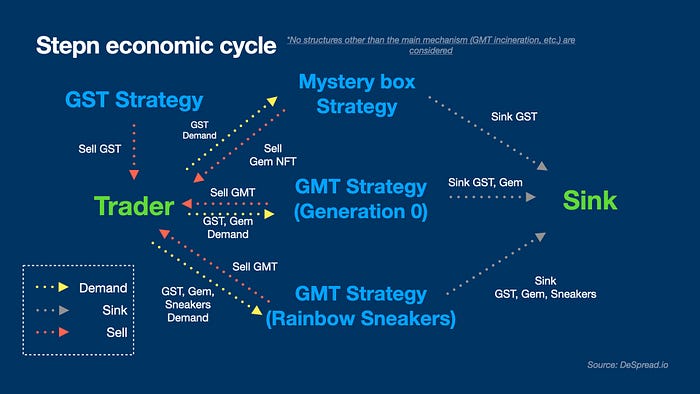

Through the completed economic circulation structure, all the GSTs generated in the game ecosystem are expended by users who perform various strategies, each of which warrants different types of game assets geared to form a balanced demand group among assets.
In addition, with the diversification of the strategic hierarchy based on the cost or difficulty level, diversifying the options of strategies that gamers can choose creates a positive effect of enriching the user experience in that each participant in STEPN can enjoy the game in slightly different ways.
3.3. Insights into gaming tokenomics
The insights on gaming tokenomics that can be obtained from STEPN’s case discussed above are as follows. However, it should be noted that the insights described below can be limitedly applied in a game ecosystem similar to STEPN (i.e., unlimited issued tokens, infinitely issued NFTs, each NFT’s own utility, etc.).
- In-game base currency should be kept at a low price.
- In-game base currency is an element profoundly related to the entry of new users into the game. If the token is used as the base currency, it should be kept at a low price so as not to compromise the gaming experience of new users. - User rewards must be made through NFT trades, and the displayed currency must be a mainnet coin that exhibits relatively small volatility compared to project-related assets.
- The mechanism should be designed to allow most of the in-game base currency to be burned up from in-game activities, and the rewards for users should be obtained through NFT trades where the mainnet coin is used as the displayed currency while also providing low price fluctuations. - It is necessary to diversify the gaming strategy and implement an ecosystem circulation mechanism that enables the assets required by each strategy level to be provided for different levels.
- User activities should result in burning sufficient assets continuously, and an ecosystem mechanism that can control the rate of inflation is needed.
4. Part II: Designing Gaming Content
4.1. Lack of content diversity
Even after the plummet of in-game GST base currency prices, the project’s efforts to increase GST incinerator sites and stabilize prices through continuous updates are viewed positively. However, the fact that STEPN’s final content is still limited to the ‘Earn’ function of GMT mining raises some doubt about the project’s sustainability.
The user group acting as the largest consumer of in-game assets is still participating in the ecosystem with the aim of profit-making, and user revenue generation leads to an increase in the GMT supply, adversely affecting the GMT token price that, in turn, reflects the project’s value. In fact, from October 1, when GMT mining began, the GMT price fell from USD 0.64 to 0.46, forming a price instability exposure from an increase in GMT circulation.
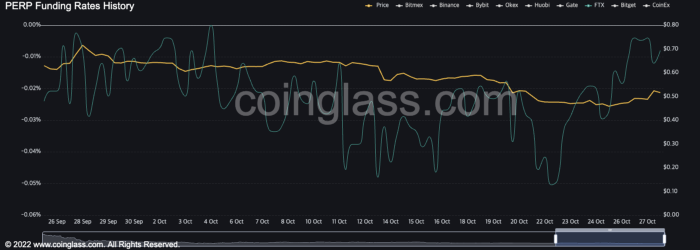
So then, how can STEPN be further improved? What’s more, in what direction should Web3 game content be designed for users to continuously participate in the game ecosystem by disincentivizing them to chase after ‘Earn’?
4.2. How users’ immersion is formed — Csikszentmihalyi’s Flow theory
Mihaly Csikszentmihalyi developed flow theory in the 1970s. As mentioned in a previous article, “immersion” refers to the state in which one feels the most positive about the experience of actively participating and performing the task when one has the initiative-taking mindset and the ability to solve it. Csikszentmihalyi explained that immersion in the subject of experience takes place when an individual’s ability and the given task’s difficulty level are properly balanced.

From this point of view, it can be said that STEPN lacked tasks with various difficulty levels that correspond to different users’ abilities/ skill sets. The tasks to be experienced at STEPN are relatively simple. One must walk or run for a longer time and distance without taking a break to win a mystery box or increase one’s GST or GMT reward. This could hardly be reasonable enough to give a task of appropriate difficulty to a user if his/her proficiency enhances while participating in the game. If you think about the above graph, most of the strategies to be taken on STEPN have a low difficulty and prevent the transition to immersion by keeping many users in the realm of boredom.
In the same vein, let’s consider “Pokémon Go” as a comparable case. Released in July 2016, Pokémon Go, having shown steady growth since 2017, has similarities to STEPN in that users actually move and play the game, and is evaluated as a leading model in the move-to-play genre. The following describes the case of Pokémon Go, which consists of various contents through content updates every year.
Description of Pokémon Go content (source)
- Complete Pokémon encyclopedia: Content that captures and collects all Pokémon species and completes the encyclopedia through the essential play of Pokémon Go.
- Gym battle: Competing with powerful Pokémon collected by users. Featuring battles to preoccupy the gym, a place that rewards more for the greater time occupied.
- Raid battle: Content that allows one to catch powerful Pokémon that appear randomly, while collaborating with other users.
- Team Go Rocket: High-difficulty level content where capture is not easy, and a lot of resources are required to upgrade while defeating Team Rocket NPCs and capturing the accompanying Pokémon shadows.
- Go Battle League: Highest level content in terms of difficulty and cost, enabling to rank up through battles between users and receive various rewards depending on the rank.

As shown in the image above, Pokémon Go comprises content of different difficulty levels according to users’ abilities and successfully brings about the user’s immersion. It will be as follows by looking at the areas of Pokémon Go and STEPN content in the graph about the above Flow theory. Compared to Pokémon Go, STEPN is not structured in terms of difficulty levels of content, so it can be evaluated that many users do feel bored and cannot immerse themselves in the game.

From this point of view, STEPN needs to release content with a new level of play difficulty. Luckily, STEPN is set to update the marathon mode in December, and the mode will be run weekly/monthly, providing high-level content that requires one to run non-stop from a minimum of 2.5km up to a maximum of 15km (refer to the tweet below). This update is expected to have a positive effect on bringing about user immersion by adding content of new difficulty levels to STEPN.
THREAD - MODE MARATHON
— Kanam (@kanamstepn) October 26, 2022
🎉 Nous l'attendons tous avec impatience, et il devrait être dispo en décembre !
✅️ Je vous récapitule les infos déjà dispo dans le Whitepaper sur le mode Marathon
🟣 Les gems Rés seront vraiment utiles ??? Réponse ici ⬇️⬇️⬇️#STEPN pic.twitter.com/gmV1EDRt42
Also, applying Jon Radoff’s perspective on gameplay motivation (i.e., immersion, achievement, competition, & cooperation) mentioned in the previous article, it can be interpreted that the game’s difficulty is relatively simplified because there is no content that requires competition or cooperation with other users. Given that Pokémon Go is overcoming these blind spots through the content of raid battle (cooperation) and the Battle League (competition), such a point of view can herald STEPN’s update direction in the future.
4.3. What rewards should be given
What kind of rewards should be given to users participating in the game? How can Web3 games get users’ continuous interest without giving them cash-out assets? The Art of Game Design, authored by video game designer Jesse Schell, explains that users are required to receive rewards by burning large amounts of virtual currency, and the types of rewards can be classified into ‘power’, ‘spectacle’, ‘expression’, and ‘compliment’. Moreover, ‘Ahn Ki-Jin, A Study on MMORPG’s Virtual Currency System: Focusing on World of Warcraft, 2012’ presents the following explanation.
- Power: Increasing a character’s “power” in helping the player overcome challenges ahead and providing a faster way to reach those goals.
- Spectacle: Showing players something beautiful and interesting
- Expression: Satisfying the player’s desire to express themselves in the game
- Compliment: Telling the player that they did an excellent job in the game
But power is the least rewarding reward. Giving too much power to one player can threaten the game’s balance and give other players a sense of relative deprivation.
(Syncopate)
These rewards don’t incur much damage to ones’ relationship with other players. Instead, one can “express” oneself by showing off self-achievements to other players, creating a “spectacle” for players, including oneself, and receiving constant “compliments”. With these reward elements, players gain great satisfaction.
- ‘Ahn Ki-jin, A Study on MMORPG’s Virtual Currency System: Focusing on World of Warcraft, 2012'
Given that token (FT & NFT) rewards become a medium for better rewards, both given by STEPN are a kind of ‘power’. Therefore, it will be possible to improve the game in a way that provides various kinds of play rewards rather than ‘power’ to users. For example, with the release of STEPN Sneakers that users with NFTs can purchase directly, it is possible to think of ways to reward others with personal characteristics that express oneself.
5. Conclusion
In the above article, we have described ways to improve the token economy and content design of Web3 games. But different types of solutions will be needed depending on the various game economy types that can be implemented using blockchain assets such as Land NFTs or C2E (create-to-earn).
Another notable example is a profit-generating method called “Battle Pass”, which has been actively introduced in the game industry recently. During a specific period, when users increase their progress by leveling up or performing tasks through game play, various rewards are given based on that. Given that it does not charge a fee from the user while giving rewards according to the level of contribution the user has made to the game, it is regarded as a sensible method.

Considering that the existing Web3 games have lacked a method to evaluate the player’s contribution other than the funds element, I think the ‘Battle Pass’ method is something that many Web3 games can adopt. Recently, SuperWalk, an M2E project based on the Klaytn chain, is giving rewards according to the user’s play time through the off-chain in-game asset SWEAT, which seems to have originated from the same problem.

The future possibilities of gaming in the mass adoption of blockchain cannot be overlooked. During the blockchain boom, Axie Infinity had a maximum DAU (daily active users) of about 2.7 million, while STEPN tallied a maximum of about 100,000 DAU. It has attracted industry attention that so many users of a blockchain application have been onboarded. In fact, according to data from Messari, out of a total USD 36.2B in funding for the crypto industry in 2022, about USD 5.3B or 14.6% was invested in the gaming sector.
However, with the short history of Web3 games, in-game economy or lacking consideration for content design is the target of criticism from many. Accordingly, many cases exist where Web3 game projects simply release tokens or NFTs without special content, leaving users to endure a long development time frame.
Amid many people’s expectations and concerns, the Web3 game is going through a transitional period. In writing this article during this unstable transitional period, I will conclude it by expressing my wish to help anyone who feels ambiguous about the question of how to improve the Web3 game.
<References>
- Boffin, ‘Designing Better Game Economies’
- Kim Hyeong-Jung, Virtual Economy in Online Games: Current Status and Prospects, 2010
- Stepn, Reflections on our game ecosystem
- 포켓몬 고 인벤, 포린이 분들이 궁금해하시던 내용 10가지
- Jesse Schell, The Art of Game Design, 에이콘, 2010
- Ahn Ki-Jin, A Study on MMORPG’s Virtual Currency System: Focusing on World of Warcraft, 2012
- Messari Fundraising Data